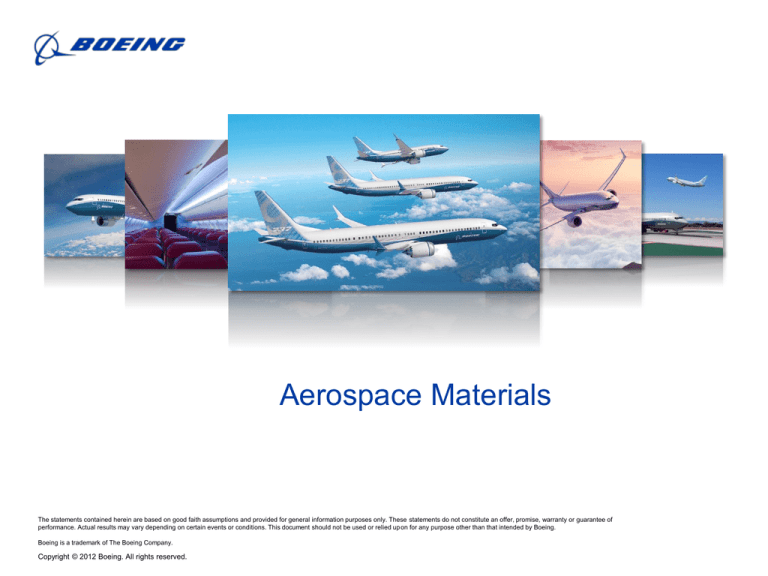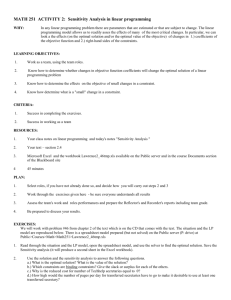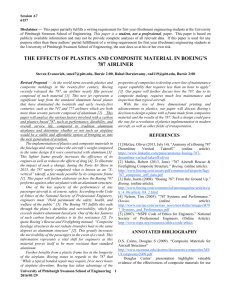
Aerospace Materials
The statements contained herein are based on good faith assumptions and provided for general information purposes only. These statements do not constitute an offer, promise, warranty or guarantee of
performance. Actual results may vary depending on certain events or conditions. This document should not be used or relied upon for any purpose other than that intended by Boeing.
Boeing is a trademark of The Boeing Company.
Copyright © 2012 Boeing. All rights reserved.
Why Advance Materials?
… to the designer
Reduced
Weight
Fatigue
& Corrosion
Resistant
New
Design
Possibilities
Copyright © 2012 Boeing. All rights reserved.
… to the factory
New
Production
Possibilities
Fewer
Parts
Reduced
Production
Cost
… to the airline
Reduced
Fuel
Consumption
Fewer
& Easier
Inspections
Reduced
Maintenance
Cost
Lower
Amortization
Cost
Longer
Life
Why Advance Materials?
Weight & Cost Improvements
Materials, Processes, & Design Improvements
Future Technology
Levels
MOSTLY UNCHARTED
2002 - 2006 Technology Level
KNOWN TECHNOLOGIES
777 Technology Level
757/767 Technology Level
737 Technology Level
747 Technology Level
Time
Copyright © 2012 Boeing. All rights reserved.
History of Composite Materials (Boeing)
787
777
757/767
747
11%
50%
3%
1%
Materials
Composite
Steel
Titanium
Aluminum
Miscellaneous
Copyright © 2012 Boeing. All rights reserved.
History of Composite Materials (Boeing)
• 747 Program – 1960’s
– Extensive use of fiberglass/honeycomb components
• Control surfaces
• Fairings
• Trailing edge panels
Copyright © 2012 Boeing. All rights reserved.
History of Composite Materials (Boeing)
• Carbon fiber concepts development – early 1970’s
– NASA-ACEE program—reaction to 1973/74 OPEC oil price increase
– Boeing designed, fabricated, and certified
• 727 elevators
• 737 horizontal stabilizers
Copyright © 2012 Boeing. All rights reserved.
History of Composite Materials (Boeing)
• Increased Production Implementation – early 1980’s
– 757/767 introduced expanded use of composites
• Material and process specifications in place
• Experienced design, fabrication, and certification personnel
• Technology jointly developed with suppliers
Fixed trailing
edge panels
Graphite
Aramid
Hybrid
Nose gear doors
graphite/fiberglass
Copyright © 2012 Boeing. All rights reserved.
Wing tips
Fin Fixed
Trailing Edge
Panels
Fin tip
Rudder
Wing-to-body
fairing
Main landing
gear doors
graphite/Kevlar
Strut forward
and aft fairings
Inboard spoilers
Engine
cowlings
Trailing edge flap
support fairings
Kevlar
Stabilizer
fixed trailing
edge panels
Outboard flap
Trailing edge
wedge
Outboard
Outboard
ailerons
spoilers
Elevators
Inboard
ailerons
Stabilizer
tips
History of Composite Materials (Boeing)
• Increased Production Implementation – early 1990’s
– 777 applied introduced expanded use of composites
Toughened graphite
Graphite
Hybrid
Fiberglass
Outboard aileron
Fin torque box
Stabilizer torque box
Rudder
Outboard flap
Wing fixed leading edge
Elevator
Flaperon
Inboard flap
Floor beams
Trailing edge panels
Leading and trailing
edge panels
Strut forward and aft fairings
Wing-to-body fairing
Inboard and
outboard spoilers
Flap track fairing
Nose radome
Main landing
gear doors
Nose gear doors
Copyright © 2012 Boeing. All rights reserved.
Engine cowlings
History of Composite Materials (Boeing)
787 Material Overview – 2000’s
Carbon laminate
Carbon sandwich
Fiberglass
Aluminum
Aluminum/steel/titanium pylon
Copyright © 2012 Boeing. All rights reserved.
Where Do Materials Matter?
• Answer – Everywhere!
• Airframe:
– Wing, Fuselage, Empennage, Landing Gear, Control Surfaces
• Interiors/Payloads:
– Seats, Overhead Bins, Linings, Bulkheads, Cargo Restraints, Floors
• Systems:
– Electrical transmission (wiring), Insulation/Isolation, Mech/Hyd systems
• Propulsion:
– Fairings, Cowlings, Exhaust, Acoustics, Fuel Systems, Pylon/Strut
• Other:
– Windows, Doors, Seals, Electromagnetic Effects (EME)
Materials Enable Design and Performance Across the Airplane
Copyright © 2012 Boeing. All rights reserved.
Now What?
• More, newer, tougher
Composites
–
–
–
–
Lighter weight
Better Damage Resistance
Better Damage Tolerance
Improved Manufacturability
• Higher temperature
Materials
– Composites
Ceramics
Polymers
– Metals
Copyright © 2012 Boeing. All rights reserved.
• Conductive Materials
– Electrical Systems
– EME/Lightning Strike
• Improved Processing
– Drilling/fastening
EME issues
– Layup
– Joining/Bonding/Welding












